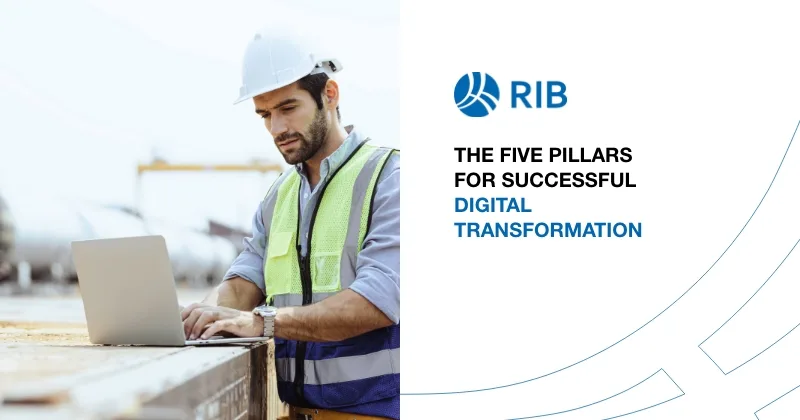5 mins read
Trusted Partner In Your Digital Transformation Journey

In conversation with Peter Damhuis, Vice President at RIB
Tell us about your role at RIB
I have been appointed as the Vice President of RIB, a role that is underpinned by more than 25 years in the construction industry and a love of the built environment.
In this role, I am committed to ensuring RIB people are enabled to do what they are passionate about and presented with opportunities for growth. Further focus will include the nurturing of relationships with the business’s current and future customers; overseeing broader changes in the business; exploring new opportunities and products; and working with my colleagues across the business’s global footprint to achieve their growth aspirations.
My many years in construction have given me a deep understanding of the complexities involved in the construction process, how challenging it can be to deliver construction projects and how important it is to have tools that are reliable and fast to secure and deliver the necessary work.
This is one of the reasons RIB Candy was my partner, my trusted assistant for the 25 years I worked at the construction coalface. It allowed my teams to secure work for the business and feel confident in the knowledge that every tender submitted would be correct.
From a project controls perspective, integration of systems helped our teams manage change more easily, with the right tools, you have access to information that allows you to make crucial decisions that influence the outcome of the project, rather than waiting for the outcome of the project to influence you.
How has technology enabled the Construction industry over the past few years and how has RIB changed the dynamics of this industry?
The construction industry is notorious for being one of the least digitally transformed industries worldwide. Although it is the single largest industry vertical in the world, it lags behind other industries in average productivity growth, only having grown by about 1% in the last decade.
Approximately 80% of all construction projects run over time and/or budget, resulting in high levels of customer dissatisfaction.
Traditionally, information on construction sites has been managed and communicated verbally and via paper[1]based systems. A common challenge with this approach is miscommunication between on-site and office personnel which, in turn, leads to delays, lost time and money, and decreased morale.
The introduction of Computer-Aided Design (CAD), Building Information Modelling (BIM), supply chain integration, and mobile computing has set the stage for the modernisation of the sector and digital tools are becoming a staple of the industry. What is missing, however, is the seamless and meaningful integration of these technologies.
Companies that are succeeding in this area have embraced innovative software, which has helped them with the identification, quantification, and streamlining of work tasks, resulting in saved time, money, and effort. Digital tools support a host of functions and when they are successfully integrated, users can improve project planning, establish accurate timelines and budgets, and track work in real-time. In addition, contractors can use the data accumulated on digital platforms to improve communication, efficiencies, productivity, and safety, thereby promoting growth, improving profitability, and enabling sustainability.
RIB’s role in the industry, which commenced more than 40 years ago, is to leverage the latest digital technologies with a view to empowering its construction clients to run their businesses better – making them more collaborative, transparent, efficient, and sustainable.
But we are now at an interesting stage within the built environment with fit-for-purpose digital solutions that allow the journey to be fast-tracked. And, that’s where RIB comes in. It’s our mission to drive the digital transformation journey of the industry so that it can prosper for many generations to come.
We live this mission when we engage our customers. It’s not just a sales process, but a partnership that lasts for many years, decades even. We become our customer’s trusted advisors and we show them not only how to use our software, but how to embed industry best practices into their organizations. We do this by hiring industry professionals who truly understand our customers’ challenges and address them via purpose-built solutions.
What are some of the projects where RIB software is/has been used that you are particularly proud of?
While our software solutions have supported various projects around the world, we are particularly proud of the high-end projects our clients have been involved in the UAE and MENA Region, including the Burj al Arab in Dubai, the Museum of the Future in Dubai, Yas Waterworld in Abu Dhabi, Qatar stadiums and infrastructure for the 2022 FIFA World Cup and the Kingdom Tower in Riyadh among many others.
What are the key opportunities in the MENA region for techno-enabled solutions?
The MENA region understands the importance of technology-enabled solutions and the role they play in economic growth and gaining a competitive advantage. Notably, about 50% of cities expected to become smart by 2025 will be in emerging markets and the Middle East.
The area is well positioned to harness its appetite for digital solutions to create viable smart cities that will, in turn, enhance the quality of services offered to their urban populations, reduce costs and resource consumption and allow for more effective engagement with citizens.
We see it has started in UAE where it is setting the example for other countries in the region and globally. Saudi Arabia as well, in line with its vision, has a major share in many techno-based projects such as NEOM and Red Sea Projects. The same goes for other GCC counties like Egypt, Kuwait and Bahrain.
What are the plans for 2023 and what’s in the pipeline for the next five years?
We have been through quite a bit of change, my position being one of them which came about when Andrew Skudder took over the role of Chief Revenue Officer of RIB. The next most notable change is to review a fragmented product-based business and to reconstitute this with a regional bias, allowing each one of the teams representing RIB in a particular region to offer multiple solutions from our broader RIB group, best suited to the needs of the client. In addition to this the RIB product team have are now actively harnessing the skillset throughout the world for the greater benefit of our clients and in turn the future of RIB.
The next five years will see a focus on our client base to ensure they can maximize the use and opportunity the software provides, focus our regional teams to embrace the multiple products offered by RIB and to bring updates as well as new solutions to the industry.
Read at Construction Business News
Most Recent
5 mins read
6 mins read
7 mins read
3 mins read
News Categories

E-BOOK











